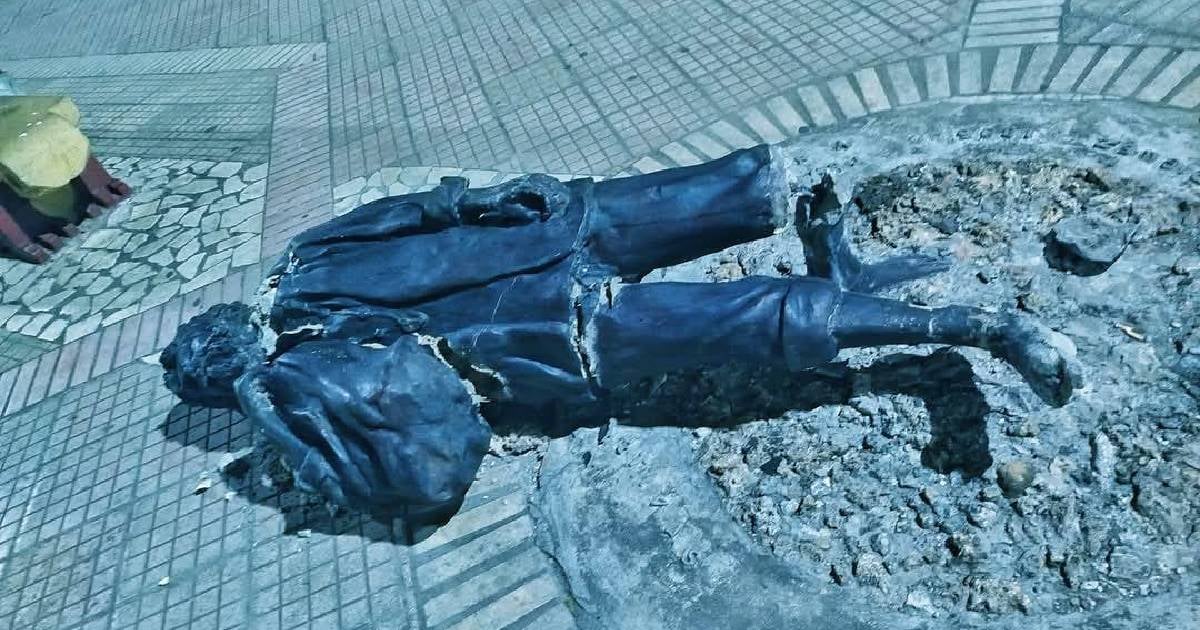The renowned statue of Baracoa's beloved Pelú, a local icon embodying the spirit of Cuba's oldest city, was found in ruins. Images circulating show the figure toppled from its pedestal, lying on the ground—a fallen symbol of a city seemingly forgetting its own identity.
More than just a statue, the Pelú represented a community's affection and collective memory, paying homage to a real person whose peculiarities and persistent presence on the streets endeared him to generations of Baracoa residents.
Sergio Enrique Ruiz Cepero, famously known as El Pelú, was recognized for his curly hair and endless walks along the seaside, often talking to himself or greeting passersby with solemnity. He became an integral part of the urban landscape, a myth, a beloved character, and a social enigma. After his death in 2009, his memory was immortalized almost a decade later in bronze by sculptor Abel Pérez Pérez.
The statue was unveiled in Baracoa's pedestrian promenade in 2018, created through a collaboration between the Cuban Fund for Cultural Assets and the Caguayo Foundation. It was a community gesture of love, symbolizing that even the marginalized, the different, and the popular deserve a place in visible history.
The first report of the vandalism came from Facebook user Lari Mar, who posted an emotional and outraged reflection in the Baracoesos group: "Only beasts could destroy something crafted with such affection for our city. What a disaster!" Her words, filled with pain and anger, condemned the "human depravity" and "lack of moral ethics" of those who not only destroyed the statue but also mocked the act publicly. Her outrage resonated with many.
Henry de Armas Acosta described the incident as "a disgrace" and demanded that the culprits "explain to the people of Baracoa and all of Cuba why they attack the culture, history, and beauty of a city." He bluntly labeled them as "killers of culture, of the history of an entire community." He also called for the case to be handled with the same seriousness as other criminal offenses.
Meanwhile, local radio journalist Pablo Gomero Machado confirmed that the statue—severely damaged—was removed the very morning of the vandalism. He highlighted that it was the work of sculptor Abel, "a figure of our history, nestled in our pedestrian walkway," and urged that justice be served and the culprits face the wrath of Baracoa residents who fiercely cherish their local history.
Additionally, Hendrys Domínguez recalled with dismay that this is not a new occurrence: "This is the second time I've heard of such an incident. I hope they catch them and make them pay dearly. Jail them!"
The photographs leave no room for doubt. The statue was violently uprooted, showing deep fractures and a crater at the base where it proudly stood. The site—a small pedestrian gazebo—now appears as the scene of a cultural crime.
As of now, local authorities have remained silent, neither offering explanations nor issuing statements. This institutional silence only adds to the public's outrage. Was it an act of vandalism? Negligence? A premeditated attack? What remains certain is that the statue of Pelú has fallen, taking with it a piece of Baracoa's soul.
Frequently Asked Questions About the Vandalism of Baracoa's Pelú Statue
Who was El Pelú?
El Pelú was the nickname of Sergio Enrique Ruiz Cepero, a beloved figure in Baracoa known for his eccentric personality and daily walks along the malecón. He became an integral part of the city's culture and history.
What does the vandalism of the statue signify?
The destruction of the statue is seen as an attack on the cultural and historical heritage of Baracoa, representing a disregard for the city's identity and the collective memory of its residents.
How have the local authorities responded to the vandalism?
As of now, local authorities have not provided any explanations or statements regarding the incident, contributing to public frustration and outrage.
